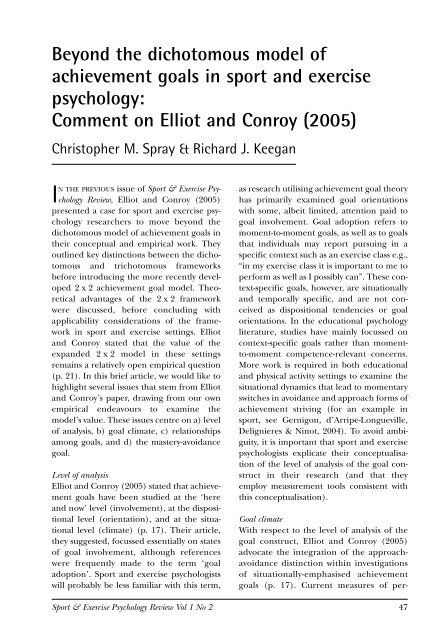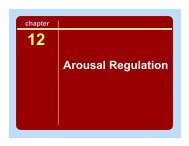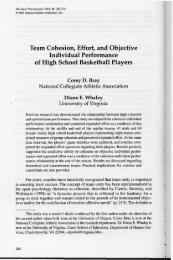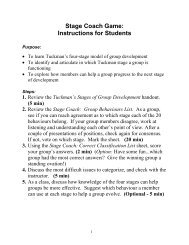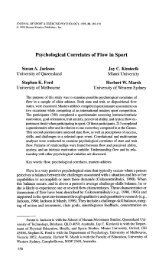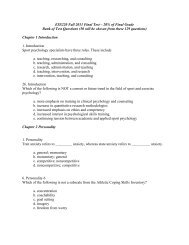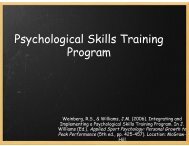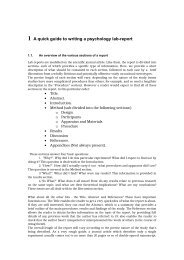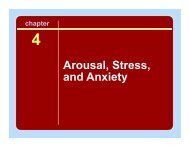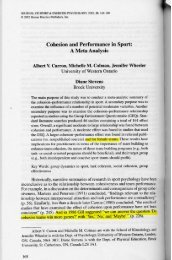Sport and Exercise Psychology Review - Sport Psychology Goes to ...
Sport and Exercise Psychology Review - Sport Psychology Goes to ...
Sport and Exercise Psychology Review - Sport Psychology Goes to ...
Create successful ePaper yourself
Turn your PDF publications into a flip-book with our unique Google optimized e-Paper software.
Beyond the dicho<strong>to</strong>mous model of<br />
achievement goals in sport <strong>and</strong> exercise<br />
psychology:<br />
Comment on Elliot <strong>and</strong> Conroy (2005)<br />
Chris<strong>to</strong>pher M. Spray & Richard J. Keegan<br />
IN THE PREVIOUS issue of <strong>Sport</strong> & <strong>Exercise</strong> <strong>Psychology</strong><br />
<strong>Review</strong>, Elliot <strong>and</strong> Conroy (2005)<br />
presented a case for sport <strong>and</strong> exercise psychology<br />
researchers <strong>to</strong> move beyond the<br />
dicho<strong>to</strong>mous model of achievement goals in<br />
their conceptual <strong>and</strong> empirical work. They<br />
outlined key distinctions between the dicho<strong>to</strong>mous<br />
<strong>and</strong> tricho<strong>to</strong>mous frameworks<br />
before introducing the more recently developed<br />
2 x 2 achievement goal model. Theoretical<br />
advantages of the 2 x 2 framework<br />
were discussed, before concluding with<br />
applicability considerations of the framework<br />
in sport <strong>and</strong> exercise settings. Elliot<br />
<strong>and</strong> Conroy stated that the value of the<br />
exp<strong>and</strong>ed 2 x 2 model in these settings<br />
remains a relatively open empirical question<br />
(p. 21). In this brief article, we would like <strong>to</strong><br />
highlight several issues that stem from Elliot<br />
<strong>and</strong> Conroy’s paper, drawing from our own<br />
empirical endeavours <strong>to</strong> examine the<br />
model’s value. These issues centre on a) level<br />
of analysis, b) goal climate, c) relationships<br />
among goals, <strong>and</strong> d) the mastery-avoidance<br />
goal.<br />
Level of analysis<br />
Elliot <strong>and</strong> Conroy (2005) stated that achievement<br />
goals have been studied at the ‘here<br />
<strong>and</strong> now’ level (involvement), at the dispositional<br />
level (orientation), <strong>and</strong> at the situational<br />
level (climate) (p. 17). Their article,<br />
they suggested, focussed essentially on states<br />
of goal involvement, although references<br />
were frequently made <strong>to</strong> the term ‘goal<br />
adoption’. <strong>Sport</strong> <strong>and</strong> exercise psychologists<br />
will probably be less familiar with this term,<br />
as research utilising achievement goal theory<br />
has primarily examined goal orientations<br />
with some, albeit limited, attention paid <strong>to</strong><br />
goal involvement. Goal adoption refers <strong>to</strong><br />
moment-<strong>to</strong>-moment goals, as well as <strong>to</strong> goals<br />
that individuals may report pursuing in a<br />
specific context such as an exercise class e.g.,<br />
“in my exercise class it is important <strong>to</strong> me <strong>to</strong><br />
perform as well as I possibly can”. These context-specific<br />
goals, however, are situationally<br />
<strong>and</strong> temporally specific, <strong>and</strong> are not conceived<br />
as dispositional tendencies or goal<br />
orientations. In the educational psychology<br />
literature, studies have mainly focussed on<br />
context-specific goals rather than moment<strong>to</strong>-moment<br />
competence-relevant concerns.<br />
More work is required in both educational<br />
<strong>and</strong> physical activity settings <strong>to</strong> examine the<br />
situational dynamics that lead <strong>to</strong> momentary<br />
switches in avoidance <strong>and</strong> approach forms of<br />
achievement striving (for an example in<br />
sport, see Gernigon, d’Arripe-Longueville,<br />
Delignieres & Ninot, 2004). To avoid ambiguity,<br />
it is important that sport <strong>and</strong> exercise<br />
psychologists explicate their conceptualisation<br />
of the level of analysis of the goal construct<br />
in their research (<strong>and</strong> that they<br />
employ measurement <strong>to</strong>ols consistent with<br />
this conceptualisation).<br />
Goal climate<br />
With respect <strong>to</strong> the level of analysis of the<br />
goal construct, Elliot <strong>and</strong> Conroy (2005)<br />
advocate the integration of the approachavoidance<br />
distinction within investigations<br />
of situationally-emphasised achievement<br />
goals (p. 17). Current measures of per-<br />
<strong>Sport</strong> & <strong>Exercise</strong> <strong>Psychology</strong> <strong>Review</strong> Vol 1 No 2 47


